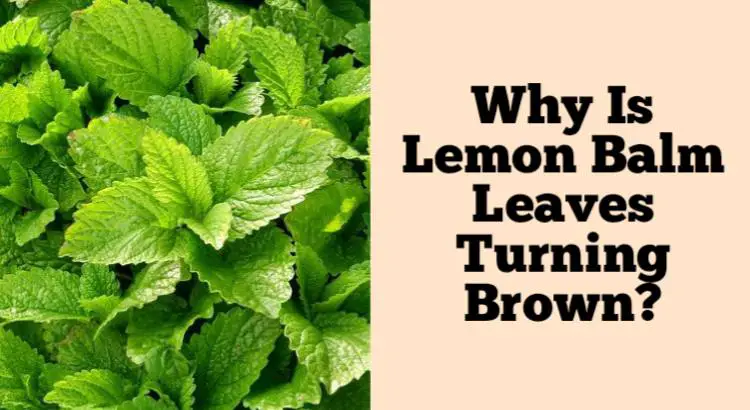Lemon balm is a perennial herb that’s native to Europe, but it also grows wild throughout the United States and Canada. Lemon balm leaves have a citrusy scent, which makes them popular in teas and herbal remedies.
You might also see lemon balm referred to as “melissa” name that references its historical uses. But if you’re growing lemon balm yourself, you may notice brown spots on the leaves or stems of your plant. What causes this?
What Causes Lemon Balm Leaves to Turn Brown?
While lemon balm is quite resilient, it won’t last forever. Over time and with neglect, your plant will start to look a bit worse for wear. This can lead to brown leaves on your lemon balm plant.
There are many reasons why this happens, including:
Lack of water – Water is essential for the growth and health of any plant, including lemon balm. If you don’t keep up with watering or provide enough water regularly (or at all), your plant may begin showing signs of stress such as browning leaves or yellowing leaves.
Lack of sunlight – Plants require light to photosynthesize which means they need energy from the sun in order to grow and produce fruit/flowers/leaves etc., so lack of light will eventually cause growth problems in plants like lemon balm.
Is It Harmful if My Lemon Balm Leaves Turn Brown?
Lemon balm is a useful herb that can be used in teas, foods and crafts. You may be wondering why lemon balm leaves turn brown. The answer is simple: They are drying out.
When you harvest fresh herbs like the ones you just bought, they will stay fresh for a few weeks if kept in an airtight container out of direct sunlight and moisture.
As soon as you pick up the container to smell its contents, you’re basically letting more air inside where it can start its work of oxidizing and turning brown over time.
This isn’t necessarily bad news because dried lemon balm leaves make great additions to tea blends or infusions—you can also make them into tinctures or use them as a garnish for soups.
However, if you want your herbs-to-be-dried looking their best before using them in recipes such as this one for sage chocolate chip cookies make sure not only that they’re dry but also green first by picking them at peak ripeness so there’s no chance any mold spores were introduced during harvest time.
How Can I Prevent My Lemon Balm Leaves From Turning Brown?
To reduce the likelihood of your lemon balm leaves turning brown, you should:
Water the plant properly. Don’t let it dry out or overwater it. You want to water it when the soil is starting to feel dry, but not too much—just a little bit at a time until you see moisture coming out of the soil. Then stop watering until you feel that same sensation again and repeat as needed.
Do not overfertilize or prune your lemon balm plant too much (if at all). This can cause leaf burn and other stress factors that may cause premature leaf yellowing and browning on some varieties of this herb.
What Should I Do if My Lemon Balm Leaves Have Already Turned Brown?
If your lemon balm plant has already turned brown, you can try to save it by trimming off the affected leaves.
To keep the plant healthy, make sure that you water your lemon balm regularly and keep its soil moist. If you live in a warm climate, try to keep the plant cool and dry during hot summer months by placing it outdoors only during evening hours.
If you live in a cooler climate, you can keep lemon balm indoors year-round. If your plant has already turned brown, trim away all of the affected leaves and new growth that emerges after cutting back. This will help to prevent further damage to your lemon balm plant.
Lemon Balm Brown Edges
One issue that lemon balm growers may encounter is brown edges on the leaves of their plants. Brown edges on lemon balm leaves can be caused by a variety of factors, including overwatering, under watering, pests, and disease.
To prevent brown edges on lemon balm leaves, growers should ensure that their plants receive adequate water, but are not overwatered. It is also important to monitor for pests and disease and take appropriate measures if they are present.
Lemon balm is a type of mint plant.
Lemon balm is a perennial herb that belongs to the mint family. It’s often used as an ingredient in herbal teas and other remedies.
If you want to grow lemon balm, you can do so by planting both seeds or seedlings. The seeds should be planted in spring or early summer, while the seedlings can be planted outside after all danger of frost has passed (usually mid-May).
Conclusion
If your lemon balm leaves have already turned brown and you’re concerned that it may be harmful to your plant, don’t panic. While it is disappointing, there are plenty of ways for you to save them—and even use them in your cooking. Just remember that plants do not always respond the same way all the time. If this happens again with future batches of lemon balm leaves, try changing some of these factors (such as sunlight or fertilizer) to see if they affect the outcome differently next time around.

